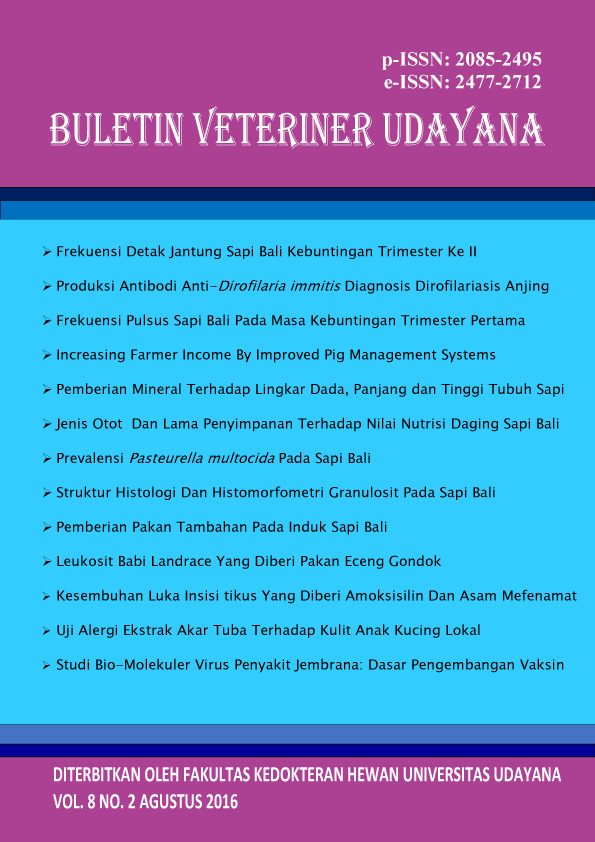THE HEALING SPEED OF WOUND INCISION WERE GIVEN AMOXICILLIN AND MEFENAMIC ACID IN WHITE RATS
Abstract
The purpose of this research was to know the recovery time of incised wound healing of white rats (rattus norvegicus) with amoxicillin and mefenamic acid therapy concern in macroscopic and microscopic perspective. The thirty two of male rats in 150-200 gram weight, divided in two random groups with 16 rats contain which are made 2 cm incised wound on linea alba with the depth to penetrate the peritoneum. The first group was given amoxicillin with a dose of 150 mg/kg body weight, whereas the second group was given a combination of amoxicillin with a dose of 150 mg/kg body weight and mefenamic acid with a dose of 45 mg/kg body weight for three days post surgery. The wound healing observed macroscopically every day for 14 days. At day 7th and day 14th, 8 rats from each group was euthanized and than the incised wound collected for histopathology examination. The result showed that the combined of amoxicillin and mefenamic acid had faster wound healing than the group which was only given by amoxicillin, where the redish and swelling mark was disappeared on the day 6th. The result of histopathologic examination has no significant differences of epitel cell, inflammatory cell, and collagen tissue of the incision wound in the white rats.
Downloads
References
Beltrani VS. 2006. Contact Dermatitis. http://www.contactdermatitis, irritantemedicinedermatology.mht. (20 Januari 2015).
Cockbill S. 2002. Wounds The Healing Process. The Welsh School Of Pharmacy. University College. Cardiff.
Fishman TD. 2010. Phases Of Wound Healing. Website: http://www.medicaledu.com/ phases.htm. (02 November 2014)
Gabriel A, Mussman, J. 2009. Wound Healing, Growth Factor. Department of Plastic Surgery. Loma Linda University School of Medicine. Birmingham.
Gayatri D. 1999, Perkembangan manajemen perawatan luka: dulu dan kini. J Keperawatan Indo, 2(8): 304-308.
Goodman. 2007. The pharmacological basis of therapeutics, 8th ed. Millan Publishing Company,1990: 207-300.
Ingold W. 1993. Wound Therapy: Growth Agents As Factor to Promotes Wound Healing. Trends Biotechnol 11, Hal 387-392.
Lorenz HP, Longaker MT. 2005. Wounds: biology, pathology and management. Ann Surg, 217(4): 391-396.
Mustika DG. Kardena IM, Pemayun P. 2015. Efektivitas plester luka pada aplikasi penutup luka insisi pasca operasi. Buletin Veteriner Udayana, 7(2): 137-145.
Price A, Wilson L. 1995. Patofisiologi. Buku 2. Edisi 4. Penerbit Buku Kedokteran EGC. Jakarta.
Robert F. 2004. Wound Healing: an overview of acute, fibrotic and delayed healing. Frontiers in Bioscience, 9: 283-289.
Rozman P, Bolta Z. 2007. Use of platelet growth factor in treating wounds and soft tissue injuries. Acta Dermatoven APA, 16(4).
Singer AJ, Clark RA. 1999. Cutaneous wound healing. NEJM, 341(1).
Suwiti NK. 2010. Deteksi histologik kesembuhan luka pada kulit pasca pemberian daun mengkudu (Morinda citrofilia Linn). Buletin Veteriner Udayana. 2(1): 1-7.
Zulfa, Murachman E, Gayatri D. 2008. Perbandingan Penyembuhan luka terbuka menggunakan balutan Madu atau balutan normal salin-povidone iodine. J Keperawatan Indo, 12(1): 34-39.





